Corpsestalker
Many tales are told around warm fires on icy nights of the horrid presence that haunts the frozen wastes. It is a creature that wanders the tundra alone, feeding off the dead and living alike. The Corpsestalker is so-named because of the misinformed belief that it is a carrion-eater, and that the buried recently-deceased will attract it. Nevertheless, it is a very real and dangerous threat to the people of Vilus.
Basic Information
Anatomy
The Corpsestalker is almost ape-like in build, though it has the long tail of a shark or crocodile. Its two rear feet are webbed to aid in swimming, while the two front ones are more like hands, its arms able to swing its razor-sharp claws at prey but walking on them while roaming the land, dragging its hefty tail behind it in the snow.
When stalking the fields of ice, it can sometimes appear ungainly, a lumbering giant slowly stumbling through the blizzards. This is until it prepares to engage, when it can break into sprints of over 50 km/hr. It is also an adept swimmer, able to break similar speeds while coursing through the icy water.
The head of the Corpsestalker, however, is something out of a nightmare. It's two alien eyes survey the landscape while a mass of tentrils hanging from its face probe the air for signs of life. Two mandibles hang down either side of a mouth of needle-like teeth, hidden until the right moment to strike.
Genetics and Reproduction
The Corpsestalker is believed to reproduce asexually, laying a cluster of eggs which comes in a large, gelatinous mass. The creature then carries on and leaves the eggs to fend for themselves.
Once it is time for the eggs to hatch, the 'tadpoles' will attack and eat one another, even devouring other unhatched eggs, until one remains the victor. With luck, this single survivor will survive to adolescence, feeding on algae and tiny shrimp. Once it is ready to progress to the next stage of its life, it will begin emerging onto land from time-to-time to see what food it can find, though it will usually retreat back to the icy water to feed on the plentiful fish found there.
Eventually, it will grow to adulthood. By this stage, its senses have become keener and it is able to hunt as effectively on land as in water.
Ecology and Habitats
The Corpsestalker is well-equipped to survive on both land and in the ocean. For reasons not yet known, it will sometimes leave the safety and bountiful food sources of the sea and emerge onto land for brief stints. There are several theories for this; they either tire of swimming and seek to use different muscles for a while, they tire of fish and seek to find alternative food sources, or they simply like to hunt land prey. The last makes the horrific Corpsestalker all the more terrifying.
Dietary Needs and Habits
Contrary to popular belief, this animal does not just feed on carrion. Despite its size and lumbering nature while on land, it is an exceptional swimmer. It will feed on anything it can find in the ocean including sharks, squids, seals and large crustaceans.
While on land (or stalking the endless expanses of frozen water) it is capable of smelling prey up to 40 kilometres away. Closer, it can even smell bodies, both living and recently deceased, that are a dozen feet deep beneath the surface.
Food is taken in through its mouth which hides beneath the mass of tentacles. The mandibles attached to its head are useful in holding food up to its face while it gnaws at it. It also has powerful claws which it can use to dig in the ice or to attack prey, should it decide to put up a fight.
Everything the Corpsestalker kills or finds, it devours to the fullest extent and then abandons the remains. There is no desire in its mind to store food for later or take it with it on its roaming.
Behaviour
Extremely solitary animals, the Corpsestalker spends most of its like hunting alone. Should it happen upon some sign that another of its kind is near, it will either keep its distance or prepare to engage. They are very territorial and do not take well to any creature invading its domain while it hunts.
Any person that comes into contact with one will likely become food.
Additional Information
Facial characteristics
The Corpsestalker's face is a cacophany of terrifying and alien-looking features, though all serve a purpose. The tendrils are lined with tiny receptors and used to sense or smell for miles around, while the mandibles serve as eating utensils, holding food or bringing into the creature's mouth so it can continue using its claws. The mandibles are also aided by the small, barbed hooks at the ends.
Geographic Origin and Distribution
Exclusively found in Vilus
Average Intelligence
Unknown
Perception and Sensory Capabilities
Each tendril which constantly curls around in the air is lined with tiny receptors. The Corpestalker uses these to effectively "smell" potential prey for up to 40 km. Their eyes only see in greyscale, and only to a distance of about 5 km, though this is hampered by snowstorms. Their sensory tendrils are their best tools for perception.
Origin/Ancestry
Unknown
Lifespan
~80-100 years
Average Height
Adult: 2.1 - 2.8 metres (3.5 standing)
Average Weight
~450 kg
Average Length
~5.4m
Average Physique
Muscular
Body Tint, Colouring and Marking
Usually pallid colours (grey, teal) with pale underside
Remove these ads. Join the Worldbuilders Guild



Comments